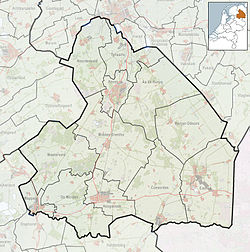Barger-Oosterveen | |
|---|---|
 Widening of the canal near Barger-Oostveen | |
Location in province of Drenthe in the Netherlands | |
| Coordinates: 52°42′10″N6°58′29″E / 52.7028°N 6.9747°E | |
| Country | Netherlands |
| Province | Drenthe |
| Municipality | Emmen |
| Area | |
• Total | 0.43 km2 (0.17 sq mi) |
| Elevation | 21 m (69 ft) |
| Population (2021) [1] | |
• Total | 310 |
| • Density | 720/km2 (1,900/sq mi) |
| Time zone | UTC+1 (CET) |
| • Summer (DST) | UTC+2 (CEST) |
| Postal code | 7891 [1] |
| Dialing code | 0591 |
Barger-Oosterveen is a hamlet in the Netherlands and is part of the Emmen municipality in Drenthe.
Barger-Oosterveen is a statistical entity, [1] however the postal authorities have placed it under Klazienaveen. [3] It was first mentioned in 1867 as Ooster Veen, and means "The eastern bog near Barge". [4]

